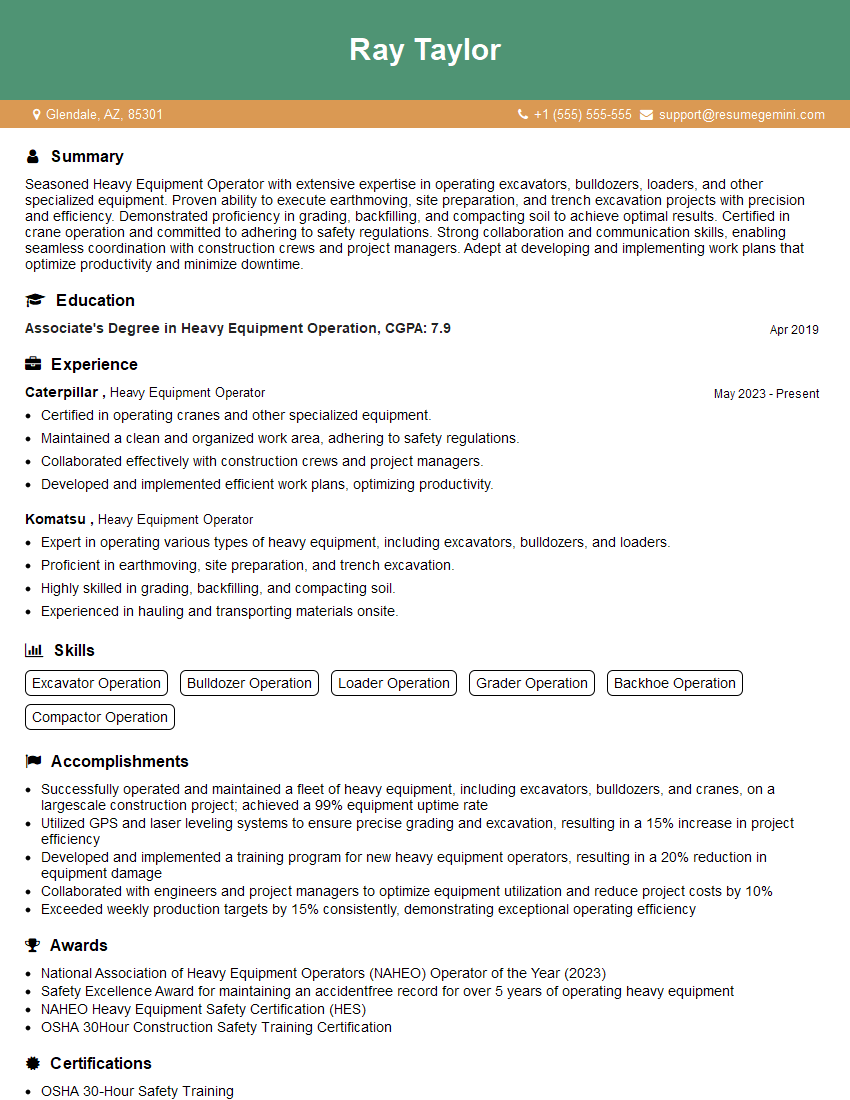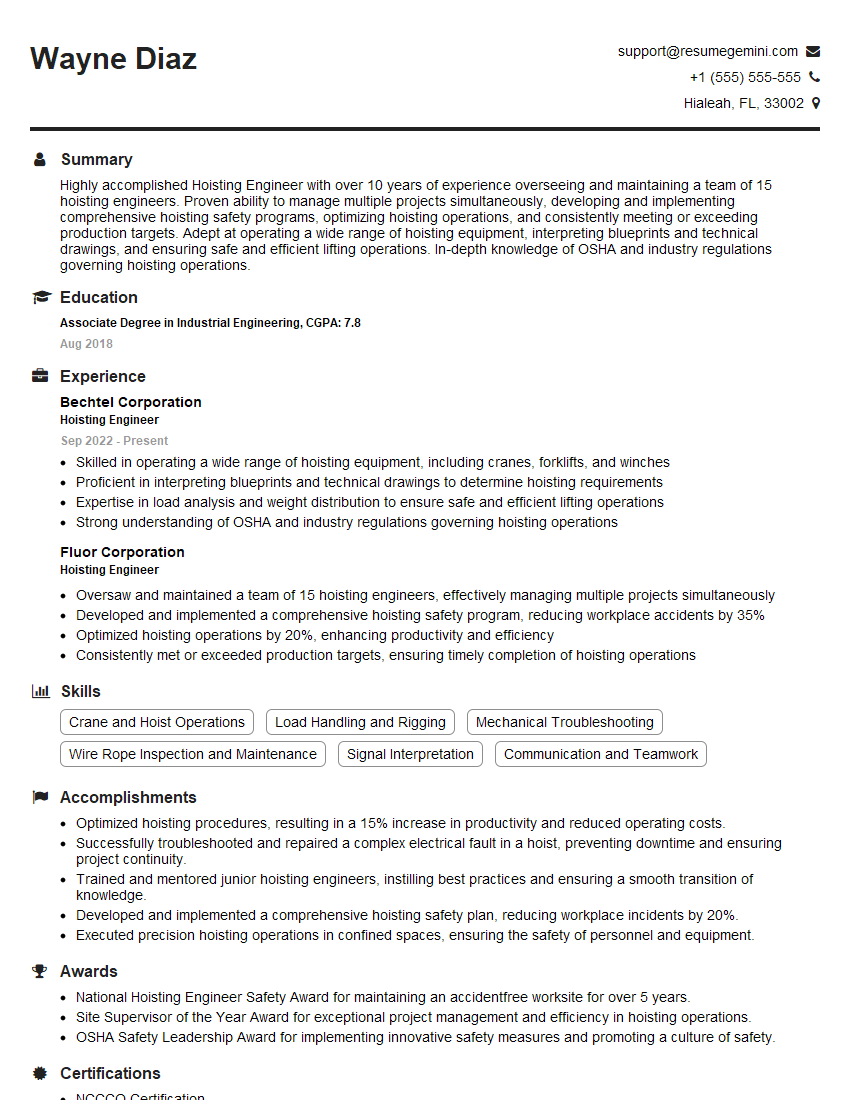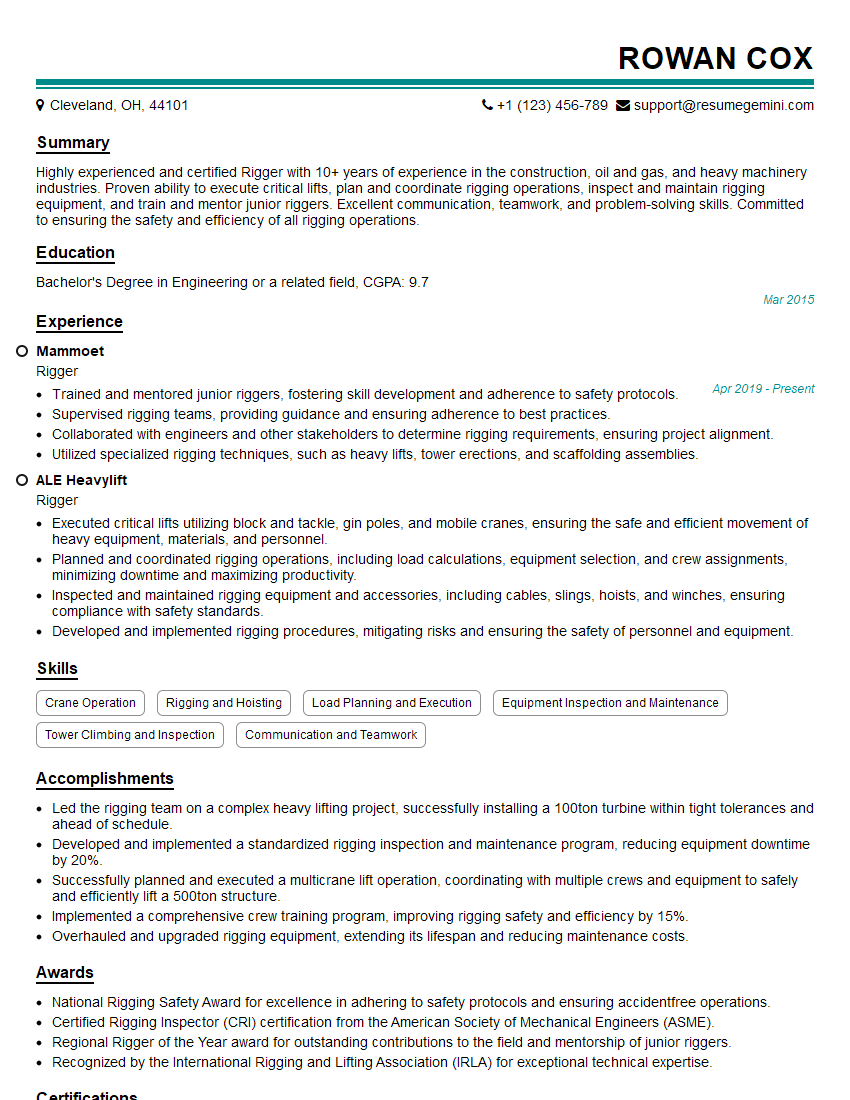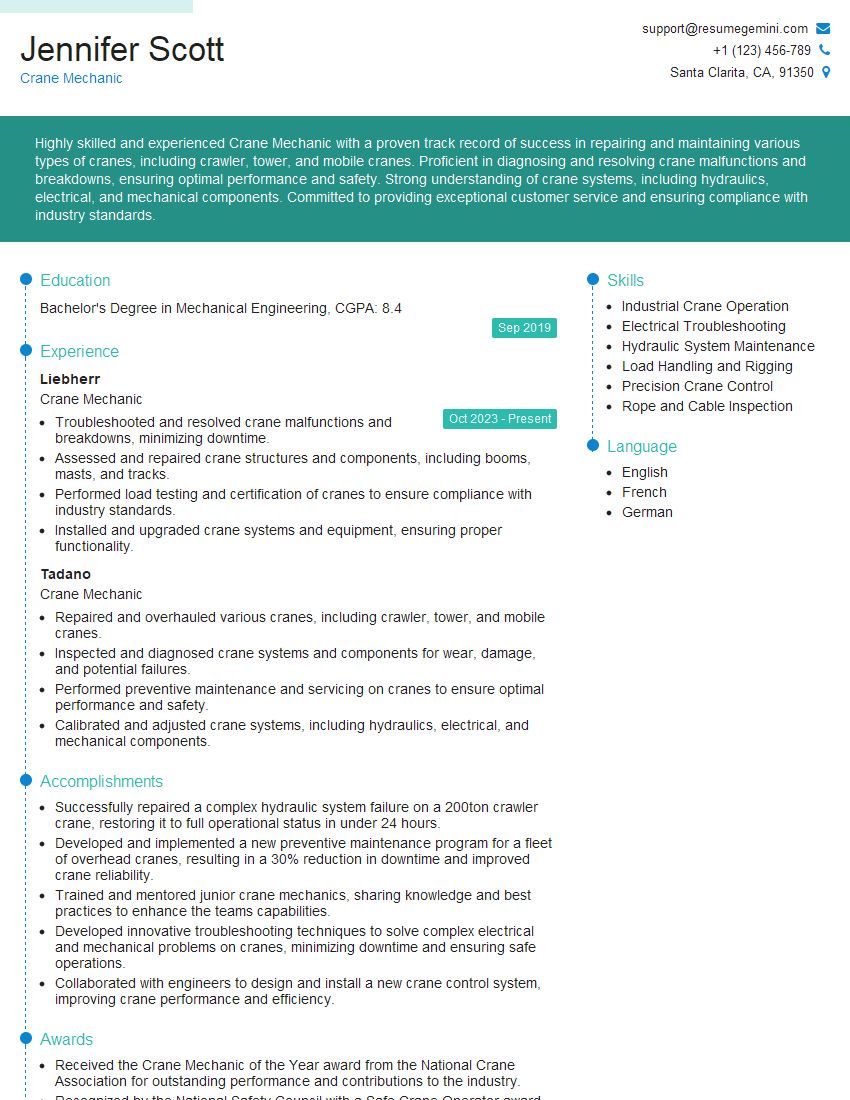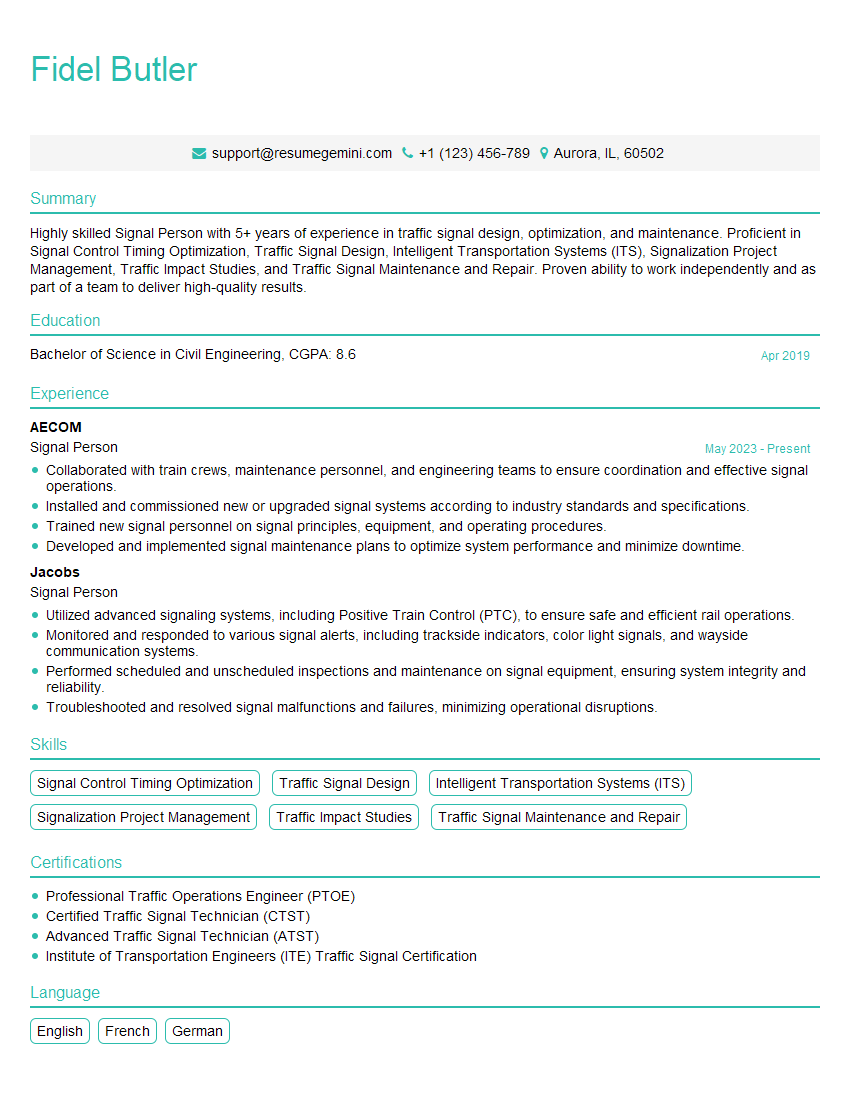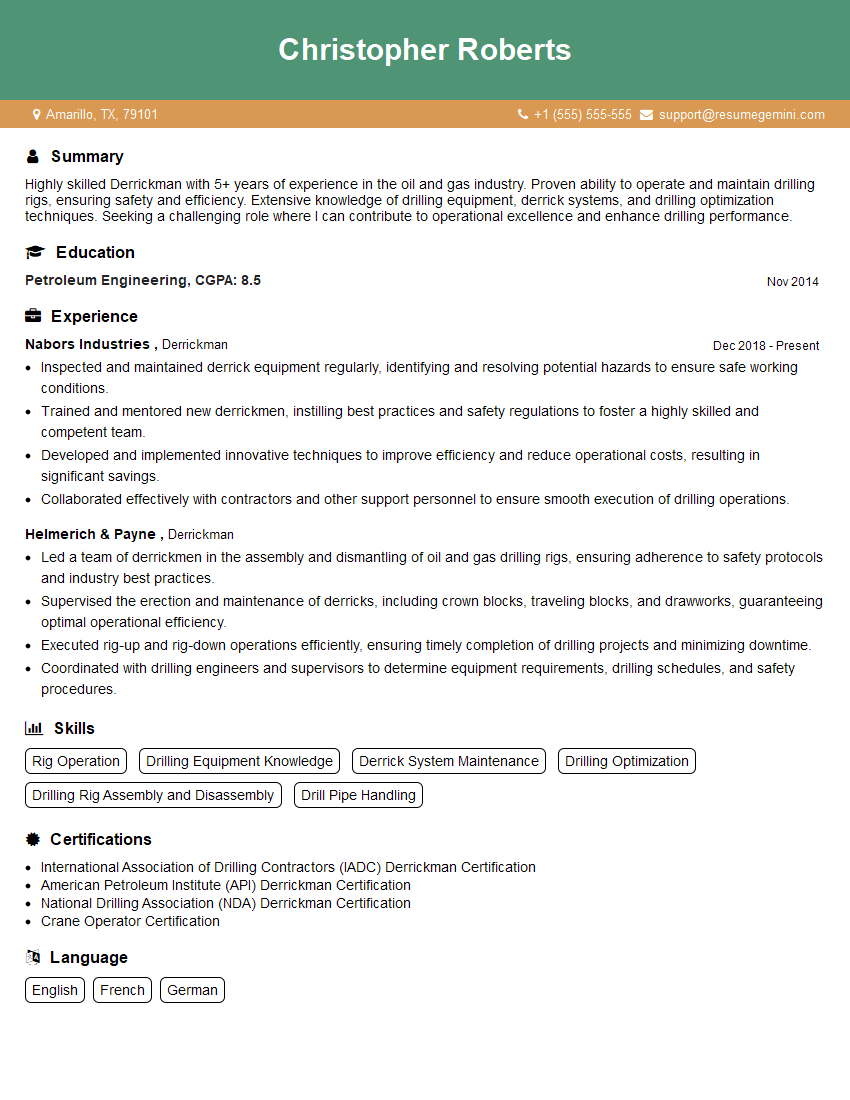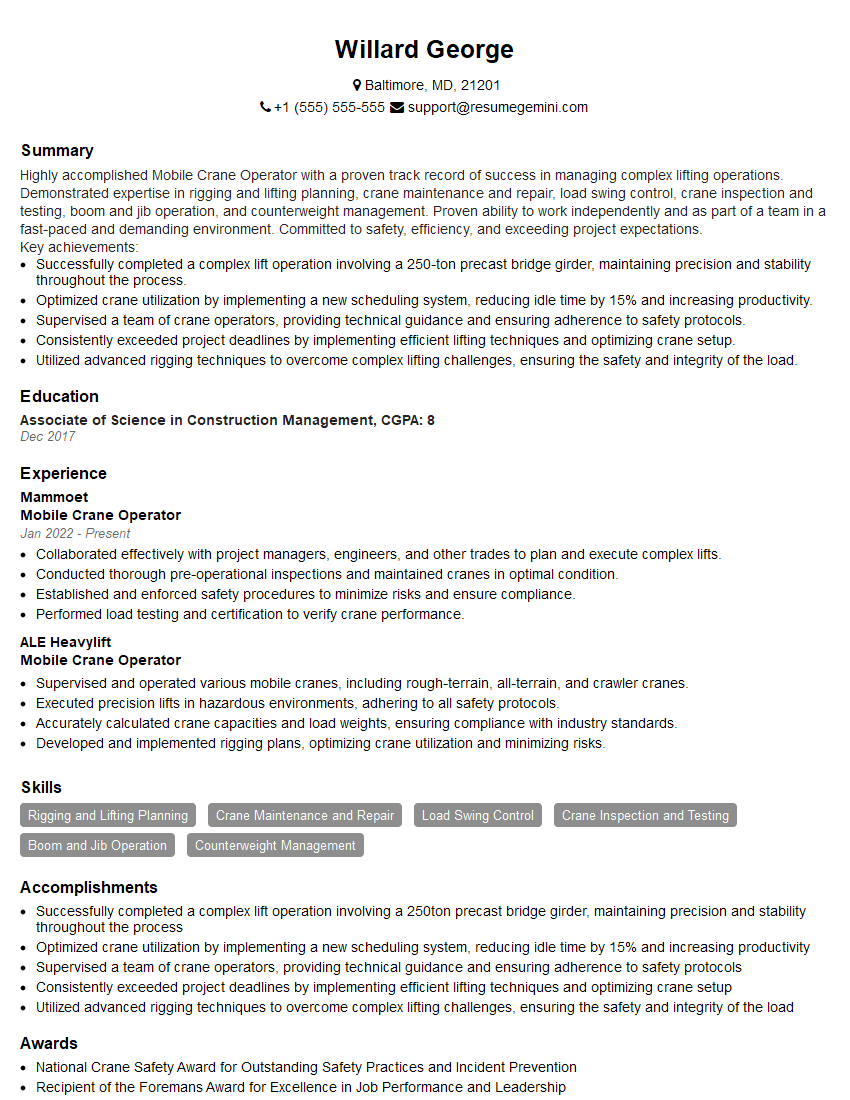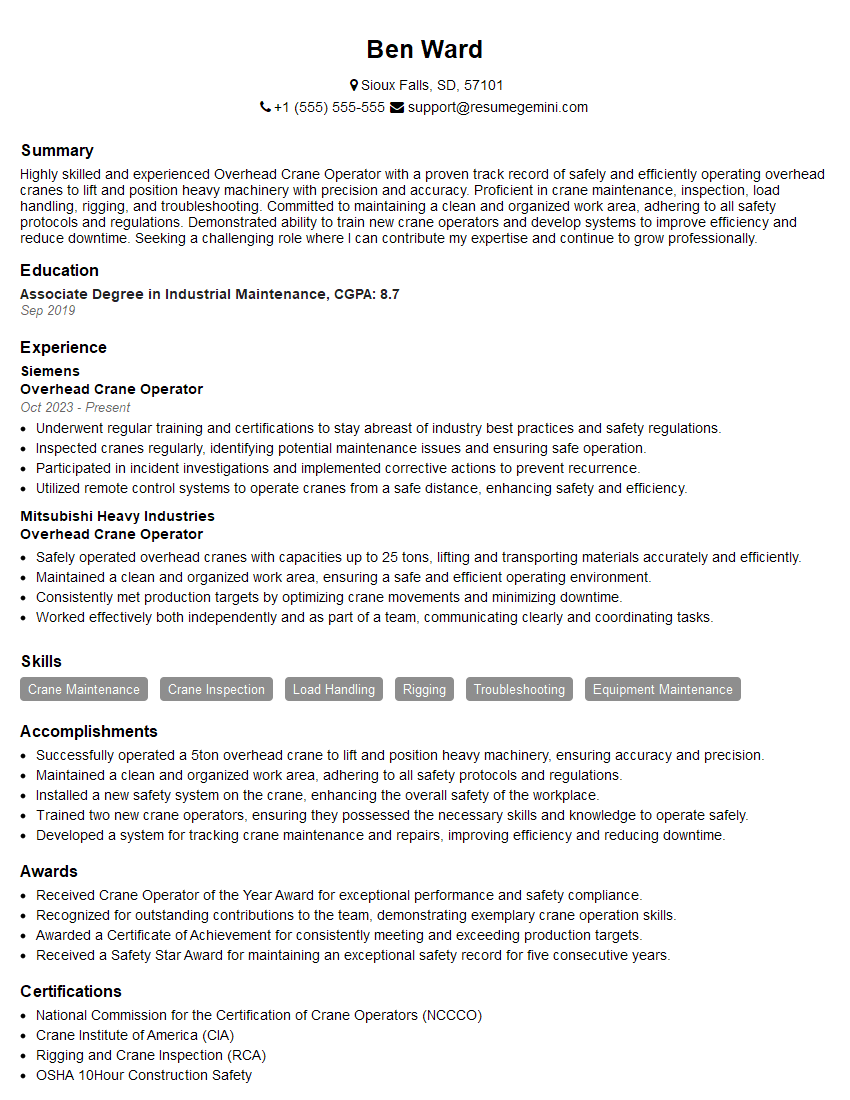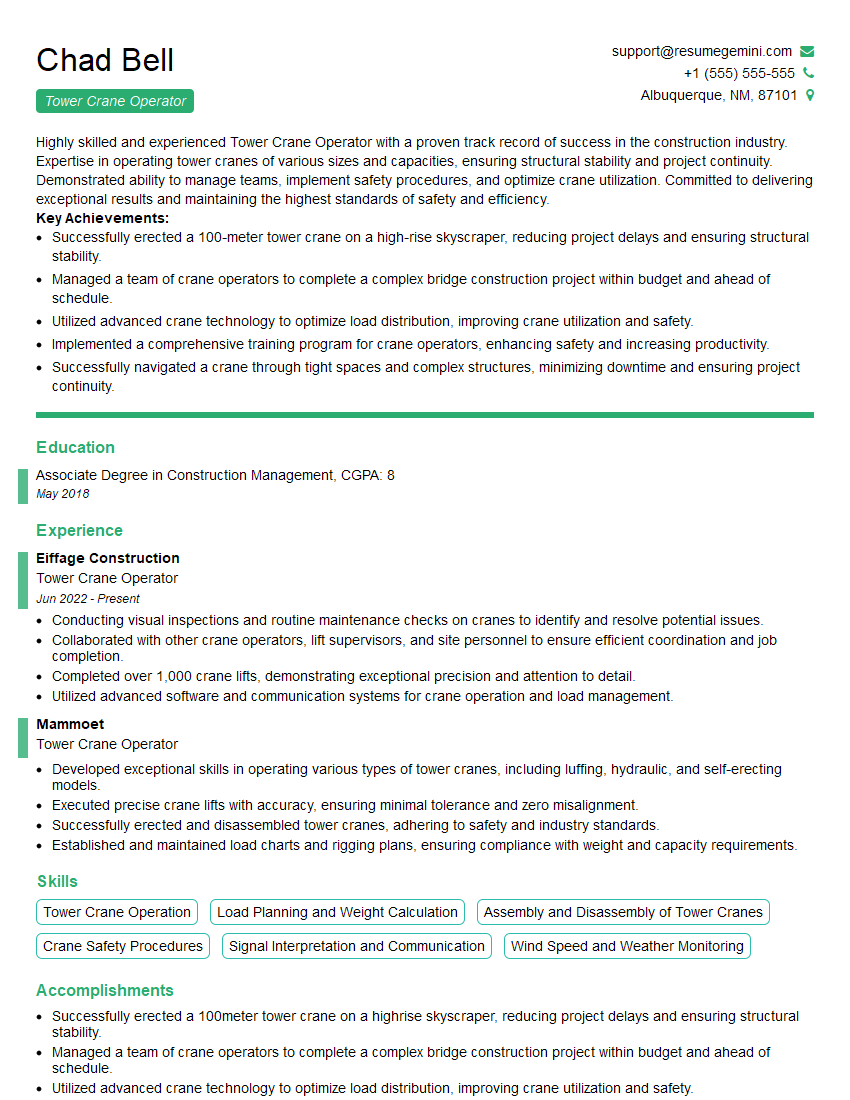Are you ready to stand out in your next interview? Understanding and preparing for Cranes and Boom Operation interview questions is a game-changer. In this blog, we’ve compiled key questions and expert advice to help you showcase your skills with confidence and precision. Let’s get started on your journey to acing the interview.
Questions Asked in Cranes and Boom Operation Interview
Q 1. Explain the different types of cranes and their applications.
Cranes are classified into various types based on their design, mobility, and application. Think of it like choosing the right tool for a job – a small screwdriver for a tiny screw, a large wrench for a stubborn bolt. Similarly, different cranes are suited for different lifting tasks.
- Tower Cranes: These are typically fixed on a building site and used for high-rise construction. Imagine them as the tireless construction workers, steadily lifting materials floor by floor. They offer high lifting capacity and reach.
- Mobile Cranes: These are self-propelled and highly versatile. Like a mobile workshop, they can be moved around a site to different locations as needed. They’re commonly used for general lifting, infrastructure projects, and industrial applications.
- Overhead Cranes: These are fixed cranes used in factories and warehouses. Think of them as the efficient internal delivery system of a large facility, moving materials swiftly within the building. They’re ideal for repetitive lifting tasks within a confined area.
- Crawler Cranes: These are large, powerful cranes that move on tracks. These are like powerful, slow-moving giants, often employed for heavy lifting tasks in construction and industrial settings, where the ground might not be suitable for wheeled vehicles. They excel in heavy lifting and stability.
- Floating Cranes: These are specialized cranes mounted on barges or ships, used for offshore construction and maintenance. These are the seafaring cranes, crucial for building and repairing oil rigs or offshore wind farms.
The choice of crane depends heavily on the job’s specific needs, such as load capacity, reach, maneuverability, and the site’s terrain and infrastructure.
Q 2. Describe the pre-operational checks you perform on a crane.
Pre-operational crane checks are crucial for safety and to ensure smooth operation. I always follow a comprehensive checklist, which includes:
- Visual Inspection: A thorough examination of the crane’s structure for any signs of damage, wear, or corrosion. This includes the boom, hoisting mechanism, counterweights, and all other components.
- Mechanical Checks: Checking the functionality of all moving parts, brakes, and safety devices like limit switches and emergency stops. I listen carefully for any unusual noises, which might indicate a problem.
- Hydraulic System Check: Inspecting oil levels, pressure gauges, and hoses for leaks in hydraulic cranes. I check for any unusual leaks or signs of wear.
- Electrical System Check: Verifying the proper operation of lights, indicators, and electrical controls. I make sure all electrical connections are secure.
- Load Test (if required): In some cases, a load test might be required to verify the crane’s lifting capacity. This is done under the supervision of a qualified person.
- Documentation: Completing all necessary paperwork, including pre-operational checklists and logbooks.
Think of it like a pilot conducting a pre-flight check before takeoff. Neglecting these checks could have severe consequences.
Q 3. What are the critical safety regulations you must follow when operating a crane?
Crane operation demands strict adherence to safety regulations. These regulations prioritize the safety of the operator, ground crew, and anyone within the crane’s operational radius.
- Load Capacity Limits: Never exceed the crane’s rated lifting capacity, considering factors like boom length and angle. This is paramount to avoid catastrophic failure.
- Proper Rigging: Using appropriate slings, chains, and other rigging equipment that are rated for the load. Inspecting them carefully for wear and tear before each lift.
- Safe Working Loads: Always refer to the load chart to determine the safe working load for the specific configuration. Ignoring this can lead to accidents.
- Communication: Maintaining clear and consistent communication with the ground crew, signaling personnel, and other involved parties is essential.
- Weather Conditions: Avoiding operation during extreme weather conditions, such as strong winds or heavy rain. Wind can significantly affect the crane’s stability and capacity.
- Emergency Procedures: Being fully aware of and prepared to execute emergency procedures in case of unexpected events.
- Personal Protective Equipment (PPE): Always wearing appropriate PPE, including safety helmets, high-visibility clothing, and safety shoes.
Safety is not just a guideline; it’s the foundation upon which all crane operations must be built.
Q 4. How do you calculate the lifting capacity of a crane for a specific load?
Calculating a crane’s lifting capacity for a specific load involves using the crane’s load chart and considering several factors. This isn’t a simple calculation, but rather a careful assessment using the crane’s specifications and load charts. The load chart provides the safe working load (SWL) for different boom lengths and radii.
Steps:
- Determine the weight of the load: This might require weighing the load or using estimations based on material density and volume.
- Identify the boom length and radius: Measure the distance from the crane’s slew ring to the load and the boom’s length.
- Consult the load chart: Locate the intersection of the boom length and radius on the load chart. The corresponding value represents the maximum safe lifting capacity for that configuration.
- Apply safety factors: Always apply appropriate safety factors, reducing the SWL to account for variables like wind speed, load configuration, and potential unforeseen circumstances. Never operate at or near the absolute maximum capacity.
- Ensure the crane is within its operational limits: Verify that the crane’s current setup, including counterweight, complies with all manufacturer specifications.
Example: Let’s say the load weighs 10 tons, and the load chart indicates a safe working load of 12 tons for the given boom length and radius. Considering a safety factor, we might reduce the SWL to 10 tons or less. Even then, we’d proceed with caution and assess the site conditions carefully.
Q 5. Explain the concept of load charts and their importance.
Load charts are essential documents that illustrate a crane’s safe working load (SWL) under various configurations. Think of them as the crane’s instruction manual for lifting weights safely. They depict the maximum weight the crane can safely lift at different boom lengths and radii. They are crucial because they prevent overloading and ensure safe operation.
Importance:
- Safety: They are the primary safety guide, preventing overloading that can lead to structural failure and accidents.
- Compliance: They ensure that crane operations adhere to safety regulations and manufacturer specifications.
- Planning: They assist in pre-planning lifts, determining the crane’s suitability for the job and ensuring its safe and efficient use.
- Legal Protection: Proper use of load charts is vital for legal compliance and liability protection.
Ignoring load charts is akin to ignoring a doctor’s prescription. It might seem inconsequential at the outset, but the consequences could be devastating.
Q 6. What are the different types of crane hooks and their uses?
Crane hooks are critical components, and various types cater to different needs. They are designed to securely grip and lift loads, but different designs handle different materials and situations.
- Standard Hook: The most common type, suitable for general lifting purposes. It’s robust and versatile but not designed for all applications.
- Clevis Hook: Features a clevis pin allowing for easy attachment and detachment of the load. This hook offers more flexibility and easier connection with different rigging elements.
- Grab Hooks: Designed to grip irregularly shaped loads, commonly used for handling scrap materials. They are great for non-uniform loads, but not for delicate ones.
- Heavy-duty Hooks: Forged steel hooks designed to withstand higher loads than standard hooks. These are employed for lifting very heavy materials, which is their primary advantage.
- Speciality Hooks: Various other hook types cater to specific needs, like those with safety latches or those designed for particular materials or load geometries.
Choosing the right hook is crucial for safety and to avoid damaging the load. A wrong choice could lead to load slippage or hook failure.
Q 7. Describe your experience with different types of crane rigging.
My experience encompasses a wide range of crane rigging techniques, adapting to diverse lifting scenarios. Rigging is not merely about attaching a load; it’s about selecting the right equipment and configuring it safely to ensure a successful and safe lift. Here are some examples:
- Single-leg Slinging: Using a single sling to lift a load directly beneath the hook. Suitable for symmetrical loads, however, the load must be balanced.
- Two-leg Slinging: Using two slings attached to the load, providing more stability and better load distribution. Often used when a single leg is not sufficient.
- Three-leg Slinging: Similar to two-leg but with three slings, providing even better stability for heavier loads. This enhances load distribution and stability, a good choice for larger objects.
- Four-leg Slinging: For maximum stability and even load distribution, often required for very heavy or awkwardly shaped loads. More slings usually means better load distribution.
- Bridle Slings: Used to lift loads from multiple points, distributing the load and minimizing stress on the lifting point. These are frequently used in non-vertical lifts.
I have experience with various sling materials, including wire rope, synthetic slings, and chain slings, selecting the appropriate material based on load characteristics, environmental conditions, and load geometry. Safe rigging is about understanding load dynamics, material properties, and securing the load properly to prevent slippage or damage.
Q 8. How do you handle unexpected situations during crane operation?
Handling unexpected situations during crane operation requires a calm, methodical approach and adherence to safety protocols. My first response is always to prioritize safety – both my own and that of those around me. This involves immediately stopping the operation and assessing the situation.
- Equipment Malfunction: If a component malfunctions (e.g., a sudden loss of power, hydraulic leak), I immediately shut down the crane and report the issue. I would not attempt any repairs myself; qualified technicians handle maintenance and repairs.
- Environmental Factors: Unexpected weather changes (strong winds, heavy rain, lightning) necessitate immediate crane shutdown. Safety is paramount; I would lower the load carefully and secure the crane before seeking shelter or waiting for conditions to improve.
- Load Shift or Instability: If I detect a load shift or instability, I would gently lower the load to a safe position, re-assess the situation, and adjust the crane’s configuration if necessary, possibly consulting with a supervisor or rigger.
- Emergency Situations: In case of an emergency (e.g., a person in danger, fire), I would prioritize emergency procedures, contacting emergency services immediately, and taking any appropriate steps to mitigate the threat, potentially involving evacuation procedures and using the emergency shutdown mechanisms.
Following established emergency procedures and documenting the incident is crucial. This allows for investigation and helps prevent similar incidents in the future. Thorough documentation is essential for my own safety and accountability.
Q 9. What are the signs of crane malfunction and how do you respond?
Recognizing signs of crane malfunction is a crucial aspect of safe operation. These signs can be subtle or obvious, and prompt action is essential. I look for:
- Unusual Noises: Grinding, squealing, or unusual vibrations can indicate wear and tear or component failure.
- Fluid Leaks: Hydraulic fluid leaks indicate potential system failure, requiring immediate shutdown.
- Warning Lights and Alarms: Modern cranes have sophisticated warning systems; any activated lights or alarms must be addressed before continuing operation.
- Drifting or Unresponsive Controls: If the crane controls respond erratically or the boom drifts unexpectedly, this signifies a serious issue requiring immediate action.
- Overload Indicators: If the crane’s load capacity is exceeded (indicated by gauges or alarms), immediate unloading is necessary.
My response to any of these signs is immediate cessation of operation and reporting. I never attempt to diagnose or repair the problem myself. I contact the appropriate personnel (maintenance, supervisor) and follow the established reporting and safety procedures. Safety is the utmost priority; any uncertainty requires immediate action and investigation.
Q 10. Explain your understanding of crane stability and tipping.
Crane stability and tipping are intrinsically linked. Crane stability refers to the crane’s ability to remain upright and balanced under load. Tipping occurs when the crane’s center of gravity shifts beyond its supporting base, causing it to overturn.
Several factors contribute to crane stability: the crane’s weight distribution, the load’s weight and position, ground conditions, and wind speed. A crane’s stability is significantly affected by the boom’s radius and the angle of the boom. A longer boom radius or a higher load increases the moment force, making it more prone to tipping.
To prevent tipping, operators must adhere strictly to load charts, ensure proper outrigger deployment (if applicable), and avoid exceeding the crane’s rated capacity. Understanding the crane’s load moment indicator (LMI) is crucial, as it displays the crane’s capacity at different boom radii and angles. Ground conditions also play a role; soft or uneven ground reduces stability. I always inspect the ground before setting up the crane.
Think of it like balancing a seesaw – if the load (or a person) is too far from the fulcrum, the seesaw tips over. Similarly, if the crane’s load is too heavy or too far out, the crane can tip over. Preventing this involves proper planning, careful calculations, and strict adherence to safety regulations and load limits.
Q 11. How do you ensure the safety of personnel around a crane?
Ensuring personnel safety around a crane is paramount and involves a multi-faceted approach.
- Designated Zones: Establishing clear exclusion zones around the crane’s operational area is crucial. These zones should be marked using appropriate signage and barriers, preventing unauthorized personnel from entering dangerous areas.
- Signal Persons: Utilizing qualified signal persons for complex lifts or situations with limited visibility enhances safety. Clear and consistent communication is essential for effective teamwork.
- Pre-lift Meetings: Conducting thorough pre-lift meetings ensures everyone understands the lift plan, potential hazards, and emergency procedures.
- Personal Protective Equipment (PPE): Ensuring all personnel wear appropriate PPE (hard hats, safety glasses, high-visibility clothing) is non-negotiable.
- Lockout/Tagout Procedures: Before performing maintenance or repairs, strict lockout/tagout procedures must be followed to prevent accidental crane movement.
- Crane Operator Training: Operators must receive comprehensive training on safe crane operation, emergency procedures, and hazard awareness.
- Regular Inspections: Routine inspections of the crane and its surroundings help identify and address potential hazards proactively.
I always prioritize safety. Even a seemingly minor oversight can have disastrous consequences. Therefore, I always maintain vigilance and adhere strictly to safety regulations and protocols.
Q 12. Describe your experience with different types of crane controls.
My experience encompasses various crane control systems, from traditional lever-operated controls to modern computerized systems.
- Lever Controls: These systems use levers and pedals for manipulating hoisting, slewing, and luffing functions. They require precise control and a strong understanding of mechanical movements. I’m proficient in operating cranes with these systems.
- Joystick Controls: These offer more intuitive control, often used in newer cranes. They provide smoother and more precise movements, especially when handling delicate loads.
- Computerized Controls: Modern cranes frequently incorporate computerized control systems with digital displays providing real-time information about load weight, boom angle, and other crucial data. These systems often include advanced safety features like load moment indicators (LMIs) and anti-two-blocking systems.
- Radio Remote Controls: I’m familiar with operating cranes using radio remote control systems, enhancing safety and flexibility, especially during difficult maneuvers or where direct access to the controls might be restricted.
Adaptability to different control systems is key. Each system requires specific knowledge and experience to operate safely and effectively. My training emphasizes understanding the nuances of each type to ensure I maintain safety and efficiency.
Q 13. How do you communicate effectively with signal persons?
Effective communication with signal persons is fundamental to safe crane operation. This communication needs to be clear, concise, and unambiguous, relying on universally understood hand signals or radio communication.
- Standardized Signals: Adherence to established hand signals or radio communication protocols is critical to avoid misunderstandings. These standards are widely accepted and minimize the risk of errors.
- Clear Visual Contact: Ensuring clear visual contact between the operator and the signal person is essential. Obstructions or poor visibility can lead to miscommunication and accidents.
- Confirmation and Feedback: The signal person should confirm each instruction, and the operator should provide feedback to acknowledge receipt. This closed-loop communication process helps ensure both parties are on the same page.
- Emergency Signals: Establishing clear emergency signals is critical. This allows immediate stoppage of operation in any hazardous situation.
- Regular Communication: Even during periods of inactivity, maintaining communication between the operator and signal person is important to ensure ongoing situational awareness.
I place a high value on building a collaborative working relationship with signal persons based on trust and mutual respect. This contributes to a safer and more efficient work environment.
Q 14. What are the different types of crane slings and their applications?
Crane slings are critical components for lifting and moving loads safely. Different types of slings are designed for various applications and load characteristics.
- Wire Rope Slings: These are highly durable and versatile, suitable for heavy-duty lifting. Different configurations (e.g., single-leg, two-leg, three-leg, four-leg) offer flexibility for various load geometries. Regular inspection for fraying and damage is essential.
- Chain Slings: Chain slings provide excellent strength and resistance to abrasion, making them suitable for harsh environments. They are often used for lifting heavy, bulky materials.
- Synthetic Webbing Slings: These are lightweight and easy to handle, often preferred for lifting lighter loads or items vulnerable to scratching. They are available in various widths and lengths and are less susceptible to damage from sharp edges compared to wire rope or chain.
- Nylon Slings: A type of synthetic webbing sling, offering high strength-to-weight ratios, excellent shock absorption, and are relatively resistant to stretching.
- Polyester Slings: Another type of synthetic webbing sling, possessing good abrasion resistance and high tensile strength. They often have higher strength and better UV resistance compared to nylon slings.
Selecting the appropriate sling type is critical for ensuring safe lifting. The sling’s capacity must always exceed the load weight, and its condition should be carefully assessed before each use. The choice depends on the load’s weight, shape, and surface characteristics, as well as environmental factors. Incorrect sling selection can lead to serious accidents.
Q 15. How do you select the appropriate crane for a specific lifting task?
Selecting the right crane involves a careful assessment of several factors. It’s not just about lifting capacity; it’s about ensuring safety and efficiency. Think of it like choosing the right tool for a job – a screwdriver won’t build a house, and a sledgehammer isn’t ideal for fine woodworking.
- Load Weight and Dimensions: The crane’s rated capacity must significantly exceed the weight of the load, considering any potential swing radius or dynamic forces. The dimensions of the load are crucial for determining the appropriate hook block and ensuring safe placement within the crane’s lifting envelope.
- Lifting Height and Radius: The crane’s reach and lifting height capabilities are vital. A tall building might necessitate a tower crane, while a smaller construction site might only require a mobile crane. The distance the load needs to be moved (radius) influences the crane’s stability and required counterweight.
- Site Conditions: Ground stability, accessibility, and any potential obstructions are critical. Soft ground might necessitate using mats or cribbing to provide a stable base for the crane. Obstacles like power lines or buildings dictate the crane’s position and maneuverability.
- Crane Type: Different crane types, including tower cranes, mobile cranes (rough terrain, all-terrain, etc.), overhead cranes, and crawler cranes, have specific strengths and limitations. The choice depends on the environment, access, and lifting requirements. For example, a crawler crane is ideal for heavy lifting in uneven terrain, while a tower crane is best suited for high-rise construction.
- Safety Factors: Always incorporate a significant safety margin. The crane’s capacity should be substantially higher than the actual load to account for unforeseen factors and prevent overloading.
Example: Lifting a heavy piece of equipment onto a rooftop requires careful consideration. A tower crane would likely be the best choice due to the height and precision needed. However, if the rooftop is small and access limited, a smaller mobile crane might be a safer, more practical option, provided it can reach the required height.
Career Expert Tips:
- Ace those interviews! Prepare effectively by reviewing the Top 50 Most Common Interview Questions on ResumeGemini.
- Navigate your job search with confidence! Explore a wide range of Career Tips on ResumeGemini. Learn about common challenges and recommendations to overcome them.
- Craft the perfect resume! Master the Art of Resume Writing with ResumeGemini’s guide. Showcase your unique qualifications and achievements effectively.
- Don’t miss out on holiday savings! Build your dream resume with ResumeGemini’s ATS optimized templates.
Q 16. Explain your experience with different types of crane maintenance.
My experience encompasses various aspects of crane maintenance, from routine inspections to major overhauls. It’s a multifaceted process that ensures the crane operates safely and efficiently. Regular maintenance is as important as the operation itself – it prevents catastrophic failures and minimizes downtime.
- Daily Inspections: This is paramount and includes checking all critical components – hydraulic systems, brakes, load indicators, structural integrity (including boom, jib, and slewing mechanisms), and safety devices like limit switches and emergency stops. Any anomalies, even minor ones, are meticulously documented.
- Preventative Maintenance: This involves scheduled servicing based on manufacturer recommendations and operational hours. It includes lubrication, fluid changes, component inspections, and the replacement of worn parts before they pose a risk. This is like changing the oil in your car to prevent engine problems.
- Corrective Maintenance: This involves addressing issues discovered during inspections or due to malfunctions. It could range from minor repairs to major overhauls involving component replacements or structural repairs. Accurate documentation of all repairs is crucial.
- Specialized Maintenance: Certain components may require specialized knowledge and tools. For instance, the maintenance of electrical systems, advanced hydraulic systems, or load monitoring systems necessitates technicians with specific expertise.
Example: During a routine inspection, I detected a slight leak in a hydraulic line. Immediate action was taken to repair the leak, preventing a potential system failure and ensuring continued safe operation. Detailed records were maintained documenting the problem, solution, and date of repair.
Q 17. What is your experience with load monitoring devices?
Load monitoring devices are essential for ensuring safe and efficient crane operation. They provide real-time data on the weight of the lifted load, ensuring it remains within the crane’s safe working load limit (SWL). These devices drastically reduce the risk of overloading and catastrophic accidents.
- Types: I’ve worked with various load monitoring systems, including load cells integrated into the hook block, electronic scales, and load moment indicators (LMIs). LMIs provide critical information about the load weight and the boom’s position, helping determine if the operation is within the safe operating limits.
- Data Interpretation: Understanding the data provided by these devices is crucial. A well-trained operator can interpret the readings to assess risks, adjust lifting techniques, and ensure that the operation remains safe.
- Integration with Crane Systems: Modern cranes often have load monitoring systems directly integrated into their control systems, providing real-time feedback and alerts in case of overloading or unsafe conditions. This improves response time and enhances overall safety.
Example: On a project, the LMI alerted us that we were approaching the crane’s SWL. By carefully adjusting the boom angle and reducing the radius, we safely completed the lift without exceeding the limits. This prevented a potentially dangerous overload situation.
Q 18. How do you manage different weather conditions during crane operations?
Weather significantly impacts crane operations. Safety is paramount, and operations must be halted or modified when conditions become unsafe. Think of it like driving in severe weather – you wouldn’t drive at high speed in a blizzard.
- Wind Speed: High wind speeds are a major concern. Many cranes have wind speed limits specified in their operating manuals; exceeding these limits risks instability and could lead to catastrophic failure. We often use anemometers to monitor wind speed.
- Rain and Snow: Heavy rain or snow can reduce visibility and make the lifting environment slippery and hazardous. This can also affect the load’s weight and stability.
- Temperature: Extreme temperatures can affect the performance of hydraulic systems, lubricants, and other components. Proper maintenance and adaptations may be required in extreme weather.
- Lightning: During thunderstorms, crane operations must cease immediately. Cranes are tall structures and can attract lightning, posing significant risk to the operator and the surroundings.
Example: During a lift, wind gusts exceeded the safe operating limit for the crane. Operations were immediately suspended, and the load was secured until the weather improved. Safety is always the priority.
Q 19. Describe your experience with working at heights.
My experience with working at heights is extensive, spanning years of crane operation and related projects. It’s an environment that requires meticulous adherence to safety protocols and a deep understanding of potential hazards.
- Fall Protection: I’m proficient in using various fall protection systems, including harnesses, lanyards, and safety lines. Proper harness fitting and connection to anchor points are crucial.
- Access Equipment: Safe access to high-level platforms and control cabins is critical. I’m familiar with various access methods, including ladders, scaffolding, and specialized access equipment, ensuring their proper use and safety.
- Awareness of Hazards: A heightened awareness of potential hazards is essential, including uneven surfaces, obstacles, and environmental factors. Regular inspections of access routes and work areas are crucial for identification and mitigation of hazards.
- Emergency Procedures: Knowing and practicing emergency procedures, including evacuation plans and rescue techniques, is non-negotiable. This includes familiarity with emergency escape routes and the location of safety equipment.
Example: On a high-rise construction project, I ensured all access points to the crane cab were secured and regularly inspected. All personnel used appropriate fall protection equipment whenever working at height.
Q 20. Explain your understanding of OSHA regulations for crane operation.
My understanding of OSHA regulations for crane operation is comprehensive. These regulations are designed to prevent accidents and injuries in the workplace. Compliance is not just a legal requirement; it’s an ethical imperative. Ignoring these regulations can lead to serious consequences.
- Operator Certification: OSHA mandates that crane operators hold appropriate certifications based on the type of crane being operated. These certifications demonstrate competency and adherence to safety standards.
- Pre-operational Inspections: Thorough pre-operational inspections are mandatory before each lift. This ensures the crane is in safe working order and identifies any potential issues before operations begin.
- Load Capacity and Stability: Operating within the crane’s load capacity and maintaining stability are paramount. Calculations for load weight, wind speed, and ground conditions must be performed accurately to ensure the lift is executed safely.
- Signalpersons and Communication: Proper signaling and communication between the operator and the signalperson are crucial, particularly in complex lifts. Clear and unambiguous signals prevent miscommunication and ensure safe execution.
- Record Keeping: Maintaining accurate records of inspections, maintenance, and operations is vital for demonstrating compliance and facilitating investigations in case of incidents.
Example: Before each lift, I meticulously conduct pre-operational checks, documenting my findings in the designated logbook. This includes checking brakes, hydraulics, load indicators, and structural integrity, ensuring compliance with OSHA regulations.
Q 21. How do you handle emergency situations during crane operation?
Handling emergency situations during crane operation requires quick thinking, decisive action, and a calm demeanor. Preparation and training are essential for effective response. It’s about knowing what to do, not just what could go wrong.
- Emergency Stops: Familiarizing myself with the location and operation of emergency stop mechanisms is paramount. This includes understanding how to shut down the crane quickly and safely in the event of an emergency.
- Communication: Clear and concise communication with ground personnel is vital during emergencies. This includes alerting emergency services and coordinating evacuation procedures if necessary.
- Load Securing: If a problem arises with the load, immediate measures should be taken to secure it and prevent it from swinging or dropping. This might involve lowering the load slowly and carefully, using additional securing mechanisms, or seeking assistance from other operators.
- Evacuation Procedures: Depending on the nature of the emergency, evacuation procedures for personnel in the vicinity may need to be implemented. This includes established escape routes and assembly points.
- Post-Incident Procedures: After an emergency, comprehensive documentation of the incident, including causes, actions taken, and damage sustained, is essential. This helps in identifying areas for improvement and prevents similar incidents in the future.
Example: During a lift, a load shifted unexpectedly. I immediately initiated an emergency stop, lowered the load slowly, and secured it before assessing the situation. The cause was identified, and corrective action was implemented to prevent future occurrences. The entire incident was thoroughly documented.
Q 22. What is your experience with troubleshooting crane issues?
Troubleshooting crane issues requires a systematic approach combining practical experience with a thorough understanding of mechanical and electrical systems. My process typically starts with a safety assessment – ensuring the area is secured and the crane is isolated before any investigation begins. Then, I gather information: reviewing any error codes displayed, listening for unusual sounds, and visually inspecting the crane for obvious damage. I prioritize safety checks and ensure the issue isn’t due to operator error, load miscalculation, or incorrect rigging before diving deeper into the mechanical or electrical components.
For instance, if a crane experiences a sudden loss of power, I would first check the power source, fuses, and circuit breakers. If the issue persists, I may use a multimeter to test voltage and current, narrowing down the problem to a specific component – a faulty motor, damaged wiring, or a problem within the control system. I have extensive experience identifying problems in hydraulic systems (leaks, pump failures), hoisting mechanisms (worn gears, broken cables), and electrical controls (malfunctioning sensors, faulty limit switches).
Documenting each step and finding root causes is crucial. This meticulous approach not only fixes the immediate problem but also prevents recurrence and ensures the crane’s continued safe operation.
Q 23. Describe your experience with different types of crane attachments.
My experience encompasses a wide range of crane attachments, each designed for specific lifting tasks. I’m familiar with standard hooks, of course, which are versatile but require careful attention to load distribution. Beyond that, I’ve worked extensively with specialized attachments such as:
- Magnet Lifters: Ideal for handling ferrous materials like steel beams or scrap metal. I’m adept at assessing the magnetic force required based on the material’s weight and shape, and also ensuring the magnet is properly secured.
- Grab Buckets: Used for bulk materials like aggregates or demolition debris. Selecting the right bucket size and closing mechanism is critical for efficient operation and minimizing spillage.
- Spreader Beams: Essential for distributing loads across multiple lifting points, ensuring stability and preventing overloading of individual hooks. Calculating the appropriate spreader beam length and considering the load’s center of gravity are vital.
- Special Purpose Attachments: These include things like vacuum lifters for handling delicate materials, and specialized shackles or slings for unusual load shapes. Proper selection and safe attachment are critical here.
Proper attachment selection is paramount for both safety and efficiency. Using the wrong attachment can lead to equipment damage, material loss, or serious accidents.
Q 24. How do you ensure compliance with safety regulations?
Ensuring compliance with safety regulations is not just a checkbox exercise; it’s the foundation of responsible crane operation. My approach includes:
- Thorough Pre-Operational Inspections: Before each shift, I conduct a detailed inspection of the crane, checking all critical components including brakes, rigging equipment, load indicators, and safety devices. I document these inspections meticulously.
- Adherence to Load Charts & Regulations: I strictly adhere to the crane’s load charts, never exceeding the rated capacity. I’m also intimately familiar with all relevant safety regulations, including OSHA standards (or equivalent for other locations) and any site-specific rules.
- Proper Rigging Techniques: I use appropriate rigging equipment—slings, shackles, and other hardware—ensuring proper load distribution, securing the load effectively, and checking for any signs of wear or damage.
- Operator Training & Certification: I hold all necessary certifications and licenses for operating the specific types of cranes in my responsibility. I also believe in continuous professional development to remain up-to-date on new safety procedures and technologies.
- Reporting & Communication: Any incidents, near misses, or equipment malfunctions are promptly reported to the relevant authorities, allowing for timely corrective actions and preventing future occurrences. Clear communication with ground crews and other personnel is maintained at all times.
Safety isn’t just a responsibility, it’s a mindset ingrained in every aspect of my work.
Q 25. Explain your experience with different types of crane inspections.
Crane inspections are critical for preventing accidents and ensuring operational efficiency. My experience covers a range of inspection types:
- Daily Inspections: These are quick but thorough checks done before each shift, focusing on obvious defects, oil leaks, and the overall condition of the equipment.
- Periodic Inspections: These more detailed inspections, often conducted monthly or quarterly, cover all critical components of the crane, including thorough examination of the braking systems, hoisting mechanisms, and electrical systems. These may involve specialized testing equipment.
- Annual Inspections: These comprehensive inspections are usually performed by certified inspectors and involve thorough documentation and testing, often requiring out-of-service time for the crane. They often include non-destructive testing (NDT) methods like ultrasound or magnetic particle inspection.
- Thorough Inspections After Incidents: Following any incident, a full investigation and inspection are mandatory, and the findings inform necessary repairs and future preventive measures. Documentation is essential here.
Each inspection type has its own specific requirements and procedures. I maintain detailed records of all inspections, ensuring all findings are addressed promptly and that the crane remains in a safe and operational state.
Q 26. How do you maintain accurate crane operation logs?
Maintaining accurate crane operation logs is fundamental for safety, compliance, and effective maintenance planning. My approach emphasizes detail and consistency. The logs contain information like:
- Date and Time: Precise record of each operation.
- Crane Identification Number: Unique identifier for the specific crane.
- Operator Name and Certification Number: Ensuring accountability.
- Load Details: Weight, type, and dimensions of the lifted materials.
- Lift Details: Height, distance, and any unusual circumstances.
- Inspections: Record of pre-operational and any other inspections.
- Maintenance: Record of any maintenance or repairs performed.
- Incidents or Near Misses: Immediate documentation of any deviations from standard procedures or safety issues.
I use standardized log sheets (often digital) that simplify recording and retrieval of information. These logs aren’t just records; they are a vital tool for trend analysis, identifying potential maintenance needs, and investigating incidents, supporting continuous improvement and safe operations.
Q 27. How do you contribute to a safe and productive work environment?
Contributing to a safe and productive work environment involves more than just my individual actions; it requires proactive engagement and collaboration. This includes:
- Promoting a Safety Culture: I actively participate in safety meetings, offer suggestions for improvements, and ensure that all team members understand and follow safety procedures.
- Mentoring and Training: I readily assist colleagues, sharing my knowledge and experience to enhance their safety awareness and operational skills.
- Following Procedures: I strictly adhere to all established safety protocols and procedures, setting a positive example for others.
- Identifying and Reporting Hazards: I promptly identify and report any potential hazards, no matter how minor, ensuring swift corrective actions.
- Respectful Communication: Maintaining open, respectful communication with coworkers and supervisors is crucial for a positive and safe work environment.
Safety is a shared responsibility, and I believe that a collaborative approach creates a more productive and hazard-free workplace for everyone.
Q 28. Describe a time you had to solve a complex problem during crane operation.
During a high-rise construction project, we encountered a challenging situation involving the placement of a large, unusually shaped prefabricated section. The piece was significantly oversized for our standard rigging setup, and the wind conditions were unpredictable. The initial plan risked instability and potential damage. The solution required thinking outside the box.
First, I reviewed the load specifications, consulted the engineering drawings, and identified multiple lifting points which allowed for a more stable lift using a custom spreader beam configuration. This required calculating the precise center of gravity of the component and ensuring that the load was distributed evenly. Second, I worked closely with the rigging crew to assemble the custom spreader beam and ensure that all attachments were secure and properly rated for the unusual load.
Third, due to the wind, I adjusted the lift sequence to minimize exposure to strong gusts. We proceeded slowly and methodically, continually monitoring the wind speed and crane stability. Through careful planning, collaboration, and a thorough understanding of crane dynamics and load behavior, we completed the lift safely and without incident, demonstrating my ability to adapt to unusual situations and devise effective solutions to complex challenges.
Key Topics to Learn for Cranes and Boom Operation Interview
- Crane Types and Capabilities: Understanding the differences between tower cranes, mobile cranes, crawler cranes, and other types; their lifting capacities, reach, and limitations.
- Safe Operating Procedures: Thorough knowledge of pre-operational checks, load charts, weight calculations, signal communication, emergency procedures, and relevant safety regulations (OSHA, etc.). Practical application includes explaining how you would handle a scenario involving an unexpected load shift or equipment malfunction.
- Rigging and Lifting Techniques: Mastering proper slinging techniques, load securing methods, and understanding the impact of different rigging configurations on stability and safety. Consider practical examples demonstrating your understanding of center of gravity and load distribution.
- Load Stability and Calculations: Demonstrating a clear understanding of calculating safe working loads, considering factors like wind speed, terrain, and crane configuration. Be prepared to explain how you would determine the appropriate crane for a specific lifting task.
- Maintenance and Inspection: Knowledge of routine maintenance procedures, identifying potential hazards during inspections, and understanding the importance of accurate record-keeping. This could involve discussing your experience with preventative maintenance schedules or troubleshooting minor equipment issues.
- Communication and Teamwork: Highlighting your ability to effectively communicate with crane operators, riggers, and other team members, emphasizing the importance of clear and concise communication in a high-stakes environment. Prepare examples illustrating your collaborative work experiences.
- Troubleshooting and Problem-Solving: Demonstrating your ability to identify and solve problems related to crane operation, rigging, or load stability. Be ready to describe your approach to troubleshooting in a calm and methodical manner.
Next Steps
Mastering Cranes and Boom Operation opens doors to rewarding and high-demand careers in construction, manufacturing, and logistics. A strong understanding of these principles is crucial for career advancement and securing higher-paying roles. To significantly increase your chances of landing your dream job, it’s essential to create a professional and ATS-friendly resume that highlights your skills and experience effectively. ResumeGemini is a trusted resource for building impactful resumes, and we offer examples of resumes tailored specifically to Cranes and Boom Operation to help you get started. Investing the time to craft a compelling resume will set you apart from other candidates and greatly improve your job prospects.
Explore more articles
Users Rating of Our Blogs
Share Your Experience
We value your feedback! Please rate our content and share your thoughts (optional).
What Readers Say About Our Blog
good

